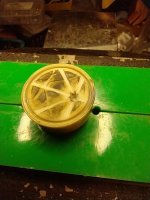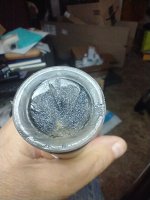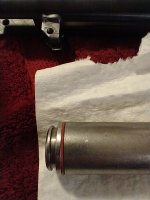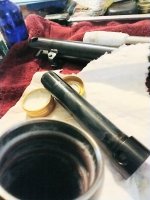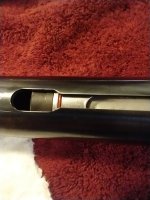I stripped down my HW90 to replace the piston seal and found one of the front stock tabs completely broken off from the cylinder (no wonder it was shooting poorly). Can the tab be welded or jb welded back on?
View attachment 304254
The same exact thing happened to one of my HW90 cylinders. In your case I would send it back to AoA.
This is a problem with the HW90 and is caused by a weak weld and high recoil. Weihrauch must be aware of this problem. Look at the HW95's. The early HW95s have the welded on tangs. The later ones have a 'fixing block' which mounts on the bottom of the cylinder. It's got holes for the stock screws and a spring for the cocking arm. Here's a picture.
https://twchambers.co.uk/twc-parts/fixing-block-with-spring/ This may be why Weihrauch supplies their breakbarrels with small, slotted forearm screws that keep you from applying lots of torque and possible breaking a tang. After my cylinder tang broke off, I became more concerned with the aftermarket brass forearm cups which come with socket head cap screws which can be tightened a lot. I had installed a set on my HW90, not sure if it contribute to the break but you never know. Nowadays I just moderately tighten the screws and count on loctite to keep them tight.
You can order a new cylinder from Krale. I did, and found it's a direct drop-in for a late model HW90. All I had to do was deburr it. Note that Weihrauch modified their piston assembly a few years ago. I don't know the date, serial number, or details of the mod. For more info check with T. W. Chambers airgun spares in England. (
https://twchambers.co.uk ). They answered my letters.
However, I got curious and was able to silver solder the tang back on.
Silver solder is almost as strong as welding, but requires much less heat. Something to keep in mind is that the solder merely flows into the break gap. It does not actually add more contact area. So you're left with a contact patch the same size as the original weld. It doesn't really solve the problem of a small weld area.
I had four temperature considerations. The barrel latching pin is hardened, you do not want to anneal it. The cylinder interior is polished, you do not want to discolor it. The cylinder itself is mild steel so I wasn't too worried about distortion. I wasn't too worried about the exterior bluing.
To locate the broken tang, I screwed a long screw through the broken tang. I then screwed it through the good tang, and adjusted the screw until the broken tang was positioned properly right over the break point. Not perfect but very close.
I used 'Muggyweld' 54% silver solder, and their proprietary flux. It's not cheap.
I started with a propane torch. That didn't have enough heat to properly flow the solder. I stepped up to MAPP gas (purchased at Home Depot). The soldering took only a couple of minutes. (I'm a total duffer with soldering and welding). MAPP is the way to go.
After soldering the only visible damage was to the exterior bluing. I had hoped to keep bluing damage under the stock. Unfortunately, some heat crept up the side of the cylinder, and you can see some bluing damage when it's in the stock. Somebody who knows what they're doing could probably do a better job. Also, a blob of solder slipped down the side of the cylinder, I ended up grinding some of that off.
The inside of the cylinder was still shiny, almost chrome like. No visible discoloration. The latching pin in the middle of the yoke seemed hard, I ran a file over it. So it didn't lose its temper. I put the cylinder in the stock, and installed the screws. Everything fit perfectly. I have not assembled the piston into the cylinder to see if it shoots properly. The main area of concern would be cylinder distortion. I don't have a way to check cylinder ID or out-of-round.
I cleaned it with steel wool and applied OXO bluing. It ain't gorgeous. More of an applied exercise.
UPDATE 12-11-22. I swapped in the cylinder, set the gun to 26 bar, and the silver soldered joint broke. So this is not a dependable fix.
